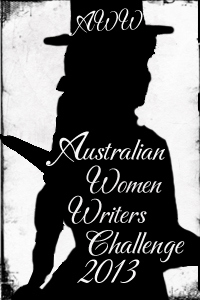Jane Downing, The Trickster, Pandanus Books, 2003. ISBN: 1740760298.
When I wound up the Dinner at Caphs project earlier this year I always intended to pop back into Caphs from time to time when something Canberra-based turned up again. There is still a lot on the list that I’d like to get to some day.
My current project is Lunch at the Raintree Cafe, pursuing my affection for the Pacific Islands through fiction. I didn’t really expect to come across anything that fit into both blogs, but here it is in the form of the highly enjoyable The Trickster.
Truth be told, the Canberra connection in the Trickster is barely more than a mention, but I couldn’t resist bringing it to you here. Before the central character, Joy, begins her travels to the centre of the world – the Marshall Islands capital Majuro – she must give up her job at the Dickson Library and “a profession steeped in words and letters and knowledge and the dusty indescribably satisfying smell of books”.
Joy’s husband Geoff has landed a development job in the Marshall Islands, and there is little question that she’ll go with him, even after she learns that she is pregnant and that her son will be born in Majuro. In part The Trickster is a story of culture shock and cultural clashes, as Joy struggles to find a life and an identity for herself as a new mother without connections and networks in a new country.
There was much in the expat experience in the Pacific that was familiar to me. The welcome party, six months after their arrival, on Marshallese Time (I still maintain Solomon Time is the most elastic of them all). Geoff’s triumph in his breakthrough model for revitalising the Marshallese economy, which turns out to be exactly the same as the model developed by his predecessor, found forgotten in a drawer. The different and seemingly incompatible approaches to work, to responsibility, to, it seems everything:
He’d come from the hustle-bustle, dog-eat-dog city life to the laid back Pacific and was suffering from stress. He had so far, and for the foreseeable future, failed to adapt to the demands of the new job. The key to the problem was somewhere in there with the absence of recognisable demands.
Reality was slipping…
The frustrations aren’t confined to Geoff’s office, and Joy’s interactions with the Marshallese around her are equally perplexing:
Joy asked, sweetly, if Mine would like to come and do some babysitting for her.
“Oh, yes. Daniel is a very beautiful baby.”
Joy left convinced that the date was set…
Though, it must be remembered, in this context ‘yes’ is open to interpretation. From birth Mine, as any child in a Marshallese family, was taught of the discourtesy of disappointing the one you are with; was warned of the insult of the word ‘no’. She was not an ill-bred person. No matter her intention she would meekly, willingly, sincerely return the much-wanted affirmative to her given companion lest she disappoint them. That this same companion would suffer no amount of frustration in the long run was not the issue under consideration.
There is more to it for Joy, though, than just dealing with misunderstandings with the locals and Geoff’s professional setbacks. Her baby son, Daniel, is fighting to keep hold of his body against the local god Letao, who is trying to move in.
Author Jane Downing has wound together a wry and amusing tale of expatriate culture shock with accounts of Marshallese folklore and legend. Letao has decided to take over Daniel’s body as a means of reminding his people of their own gods, by rivalling the hold on them that the new god Jesus has achieved. Along the way we learn something of Letao’s past adventures and exploits – the creation and other stories of the Marshall Islands that explain the world and nature’s order.
We learn of the creation of the MarshalIslands, when Letao steals a basket of earth from his father Wulleb, which leaks:
First a drop, then a dash, a sprinkle, a scatter, a globule plonking splat alone, a last dribble… The earth for his new home was wasted on these two chicken-feed chains of islands. He threw the basket down in disgust, to a spot where it became known as Kili.
Downing has found a novel way of passing on Marshallese legend to a foreign audience, without either appropriating or belittling the legends. These are living stories, fighting to be retained and remembered and valued. And for Joy and Daniel they are not merely stories but reality. Forces to be reckoned with, still shaping the world and shaping lives. While Pacific legends and Pacific ways of life might seem incompatible with western custom and outlooks, they are powerful forces still, and won’t be dislodged easily.


